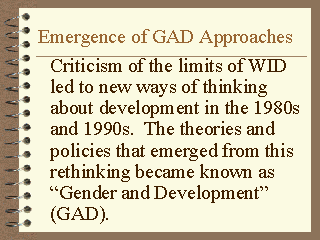| front |1 |2 |3 |4 |5 |6 |7 |8 |9 |10 |11 |12 |13 |14 |15 |16 |17 |18 |19 |20 |21 |review |
 |
GAD approaches argued that: 1. Development processes in poor countries or less-developed countries (LDCs) were deeply influenced by the inequitable structures of the international economic system. 2. Women have always been integrated into development processes, but those processes essentially flawed. 3. Men, as well as women, are hurt by development programs that do not alter repressive class, ethnic, and racial structures. 4. One cannot assume women’s solidarity across class and racial lines, but patriarchal values and institutions may oppress women in every social-economic category. 5. Development policies should not isolate women’s productive or reproductive roles: they are intertwined in women’s lives. 6. Women are agents of change and must organize politically. 7. Successful development does not "target" women, it empowers them. |